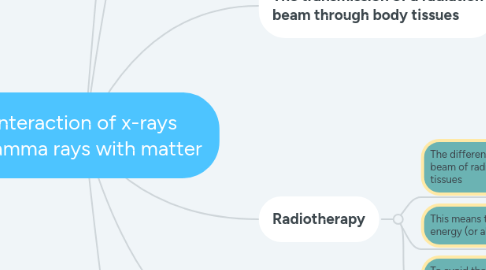
1. the transmission of a heterogeneous beam through medium
1.1. when heterogeneous beam of radiation pass through a uniform medium
1.1.1. it does not follow the exponential low
1.2. the different part of a heterogeneous beam are attenuated in different amount
1.2.1. therefore the spectrum of the radiation will be altered `
1.2.1.1. when it passes through a medium
1.3. the range of radiation energies use in radiology
1.3.1. photoelectric absorption process + compton scattering dominate
1.4. the attenuation coefficient is greater when the energies of photon are lower
1.5. when a heterogeneous beam of radiation pass through larger depth in a medium
1.5.1. more energetic photon remain after attenuation in the medium
1.5.1.1. the radiation beam is said to be harder
1.6. the total intensity of radiation at a point = the sum of the primary beam at that point + the intensities of all scattered
1.6.1. characteristic + annihilation radiation that pass through the point
2. Sequence of events when radiation interact with body tissues
2.1. When gamma or x-rays pass through matter, the interaction occurs causes
2.1.1. reduction in intensity of the beam of the radiation.
2.2. Some of the energy is absorbed by the medium and the other scatters out of the beam.
2.3. The part of the energy absorbed by the body or the medium
2.3.1. causes the biological and chemical changes observed
2.4. The energy is absorbed through different interaction processes
2.4.1. and it is transferred, initially, into kinetic energy of the secondary electrons in the medium.
2.5. The electrons move within the medium creating excitation and ionization of atoms and molecules
2.5.1. therefore, causing chemical changes in the medium.
2.6. The ionization and excitation may occur in important biological molecules,
2.6.1. thus, direct biological injuries or death may occur to cells
2.6.1.1. This type of biological effect is termed direct biological effect.
2.7. Alternatively cells may be killed indirectly as a result of chemical changes that occur in the medium around the cells which is purely intercellular fluids
2.7.1. therefore, the biological effect here is indirect.
2.8. The time delay between the exposure to radiation and appearance of the effects is known as
2.8.1. the latent period
2.8.1.1. For example the latent period for erythema may be one week.
2.9. The biological effects are known as
2.9.1. somatic
2.9.1.1. if the effects are observed on the individual subjected to radiation exposure,
2.9.1.1.1. i.e. the cell affected are somatic cells.
2.10. If the cells affected are reproductive cells
2.10.1. such as chromosomes or genes,
2.10.1.1. the effect is known as being hereditary.
2.11. There are two types of biological effects categorized according to
2.11.1. the radiation doses needed for each to be prominent.
2.11.1.1. Stochastic biological effect
2.11.1.1.1. which are the effects that does not need a threshold dose to reveal the effect
2.11.1.2. Non-stochastic biological effects,
2.11.1.2.1. which are the effects that need a threshold radiation dose to reveal the effect,
2.12. No linear relationship between the effect and radiation dose.
2.12.1. due to repair process that occur in the injured cells
2.12.1.1. The severity of effect increases with dose received.
2.13. It is found that the hereditary biological effects of radiation are all stochastic,
2.13.1. where as the somatic effect can be either non-stochastic
2.13.1.1. e.g. erythema, or stochastic, e.g. leukemia
3. Radiotherapy
3.1. The difference in the attenuation when a beam of radiation passes through a body tissues
3.1.1. there will be difference in attenuation in bone and soft.
3.2. This means that absorption of greater energy (or absorbed dose)
3.2.1. will occur in bones than in soft tissue.
3.3. To avoid the larger radiation energy absorbed by the bone than in soft tissue,
3.3.1. high photon energies are used to treat tumours underneath the bone
4. The transmission of a radiation beam through body tissues
4.1. The body tissues can be considered as been two main types i.e.
4.1.1. bone.
4.1.1.1. Bone consists of high atomic number elements such as calcium (Z = 20), phosphor (Z =15).
4.1.2. soft tissue.
4.1.2.1. Soft tissue consist of relatively low atomic number elements such as hydrogen (Z=1) and carbon (Z=6).
4.2. Therefore, when photoelectric process dominates
4.2.1. the attenuation in the bone will be much higher than in soft tissue,
4.2.1.1. because the mass attenuation coefficient for photoelectric absorption is proportional to atomic number.
4.3. When Compton process dominates,
4.3.1. the differences in the component of bone and soft tissue do not create a big variation in the attenuation,
4.3.1.1. because mass attenuation coefficient for Compton process is independent of atomic number.
5. Filtration
5.1. The principle of radiation filters is to remove the photons of low energies from the beam of radiation.
5.1.1. The beam becomes harder after filtration,
5.1.1.1. i.e. has high penetration power (high energy) after filtration.
5.2. Filtration has important indication in medical radiology
5.2.1. where the low energy radiation found in x-ray beam emerging from an x-ray tube
5.2.1.1. can be absorbed in the skin of a patient if not filtered and create biological effect on the patient’s skin.
5.3. Different type of filters are use in medical x-ray tubes
5.3.1. depending on the applied voltages used so that different elements and thicknesses are used,
5.3.1.1. e.g. Al. Cu, tin, or lead of one to two mm thicknesses.
5.4. Filters are either simple (one element) or compound (two or more elements)
5.4.1. where a primary element at the front of the filter.
5.4.1.1. Examples of filters according to applied voltages used:
5.4.1.2. Less than 120 kVp Aluminum simple filter.
5.4.1.3. 120 -250 kVp copper (Cu) as a primary element in a compound filter.
5.4.1.4. 250 – 400 kVp tin as a primary element in a compound filter.
5.4.1.5. 800 kV - 2 MVp lead as a primary element in a compound filter.
